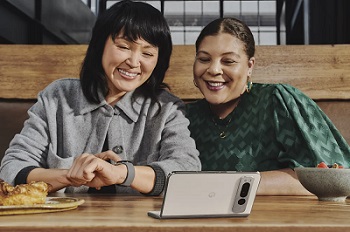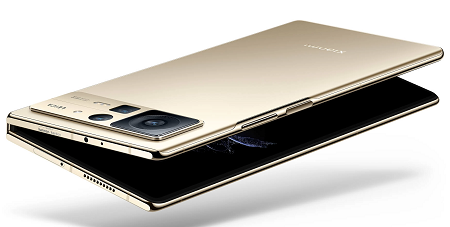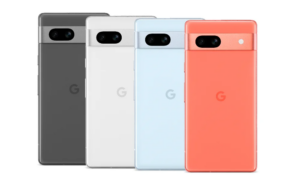Your next smartphone will be powered by either iOS or Android. With the former, you’ll be getting a rather simple phone with a great camera for most scenarios. The latter is that of customization stans.
But we’ve been witnessing a narrowing gap in recent times. Apple is easing things, and now iPhone users can enjoy a little bit of freedom. Conversely, photography has greatly improved on Android devices.
Google particularly stands out with its Pixel line of phones. The photogenic adore them, and Google keeps adding a ton of new features to keep those buttons clicking whenever something picks their interest.
![]()
This is besides having also established its Pixel software as arguably the best Android take on the market. The clean UI with close focus on simplicity and user-friendliness has made it quite popular.
While Pixel sales numbers may disagree, for the most part, it’s due to the limited availability of the phones. And this is where Samsung and Apple thrive.
Not only do they have local presence in virtually all markets across the globe, but they also stand out in terms of hardware and software alike. Samsung, particularly, has come a long way with its current One UI skin.
But what makes smartphone brands stand out?
The general consensus is that smartphone hardware has matured, and there’s not much any vendor can do to “innovate” the current glass slabs into something fundamentally different.
This explains the recent emergence of foldable phones, with companies attempting to break the norm. But even so, it’s a long way to go before foldables go mainstream. For now, they remain accessible to the opulent.

Rather than reinvent the wheel, companies have resolved to software tricks in order to come out unique. There are things the iPhone can do that no Android can mimic. The opposite is also true.
For instance, the iPhone gives you access to things like iMessage, FaceTime and AirPlay out of the box. You’ll need a third-party to enjoy close to similar functionality on Android.
Similarly, Android has things that iPhone users would relish, among them proper default app selection, custom icon packs, flexible home and lock screens, and most of all, better handling of notifications.
But it gets even more interesting with Android, where various vendors set themselves further apart with some interesting software features.

Samsung has things like the Edge Panel, Good Lock, custom AOD and DeX. The company has also greatly improved its software update policy, promising up to 5 years of support. Only Apple offers more, with up to 7 years of support.
Google was once the king of software updates for Android users. But as noted, Samsung has since taken over the crown. Still, Google hasn’t completely lost its magic hat of software tricks.
In fact, it’s the company’s software prowess that makes the Pixel line of phones the best in photography. Not only this, but you also get a bunch of Pixel exclusive features that you won’t find anywhere else.

The Pixel 6, for instance, arrived with exclusive support for Magic Eraser, face unblur, and on-device live translations, among others. The Pixel 7 upped the notch with the likes of Quick Tap, Smart Selection, and Photo Unblur.
While you’ll find the equivalent of Magic Eraser on Samsung devices, you won’t find the likes of Call Screen, Hold for Me, Direct My Call or even Now Playing not only on Galaxy phones, but also any other smartphone.
These are the features that make the Pixel series unique, just like Apple and Samsung have their own features that set iPhones and Galaxy devices apart from other smartphones.
![]()
But in a recent turn of events, Google has been making some of the features that made the Pixel line up stand out available to not only other Android brands, but also Apple – one of its biggest rivals.
Earlier this year, for example, Google Pixel’s Magic Eraser became available to every Android and iOS user who could afford a Google One subscription.
Interestingly, Google had just splashed big money on a Superbowl commercial featuring the exclusivity of the feature on the Pixel 6 and 7 series as a major selling point.
https://www.youtube.com/watch?v=zkHdpA-drz0
Enhancing videos with the HDR effect that was also showcased in the SB ad as a Pixel exclusive feature also made it to other devices through Google One. This subscription also gives you access to new Styles in collage editor.
While these features losing their Pixel exclusivity opens the door for newer Pixel-exclusive features, Google is probably hurting its efforts to expand to other markets.
By making some of the features that made the Pixel brand stand out available to everyone, the Pixel will no longer be that appealing since whatever made them desirable can easily be accessible through Google One.
It’s for the same reasons Apple won’t cave in to Google’s RCS pressure. Because iMessage is one of the features that makes the iPhone unique.
![]()
Given the other well-documented issues related to overheating, poor network connectivity, slow/inaccurate fingerprint scanner, a dogged battery life and the known hardware quality standard, the Pixel could be a hard sell in most markets without these software tricks.
I know this might not sit well with everyone. I have had similar thoughts in the past too. But still, I think Google needs to slow down with this new approach, unless they have given up on expanding the Pixel line globally.
Which leads me to my question for you guys – do you think Google making exclusive Pixel features available to everyone is good or bad for the growth of the brand?
Share your thoughts in the comments and vote below.
Featured image: Google
PiunikaWeb started as purely an investigative tech journalism website with main focus on ‘breaking’ or ‘exclusive’ news. In no time, our stories got picked up by the likes of Forbes, Foxnews, Gizmodo, TechCrunch, Engadget, The Verge, Macrumors, and many others. Want to know more about us? Head here.


